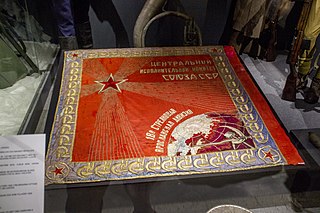The 1st Red Banner Army was a Red Army field army of World War II that served in the Soviet Far East.
A mechanised corps was a Soviet armoured formation used prior to the beginning of World War II and reintroduced during the war, in 1942.
The 23rd Army was a Field Army of the Soviet Union's Red Army.
The 16th Army was a Soviet field army active from 1940 to 1945.
The 39th Army was a Field Army of the Soviet Union's Red Army during World War II and of the Soviet Army during the Cold War.
The 36th Army was a military formation of the Red Army and the Soviet Ground Forces, formed twice.

The 18th Rifle Division was an infantry division of the Soviet Union's Red Army during the Russian Civil War, Polish–Soviet War, Winter War and World War II. The division was formed a total of five times during this period.
The 7th Guards Cavalry Corps of the Soviet Union's Red Army was a cavalry corps active during the Second World War. It was formed from the 8th Cavalry Corps in February 1943.
The 31st Army was a field army of the Red Army during the Second World War.
The 32nd Army was a formation of the Soviet Army during World War II. The army was formed twice during the war, disbanded as part of the post-war demobilization and then reformed in 1969 to protect the Soviet-Chinese border.
The 17th Guards Rifle Division was an infantry division of the Red Army during World War II. It was created on March 17, 1942, from the first formation of the 119th Rifle Division, in recognition of that division's stalwart defense against German Army Group Center in the Battle of Moscow, and in the subsequent strategic offensive that threw the German forces back from the capital. It became the 123rd Guards Motor Rifle Division in 1957 and converted into the 129th Guards Machine-Gun Artillery Division in 1989. In 2001, it was converted to the 17th Guards Motor Rifle Division and became the 70th Guards Motor Rifle Brigade in 2009. The brigade was reorganized as the 114th Guards Motor Rifle Regiment of the reformed 127th Motor Rifle Division in 2018. The regiment is currently based in Ussuriysk.
The 34th Rifle Division was an infantry division of the Red Army during and before World War II. The division was formed in 1923. It fought in the Soviet invasion of Manchuria in August 1945. Postwar, it became the 11th Machine Gun Artillery Division.
The 36th Rifle Division was a division of the Red Army and then the Soviet Army. The division was formed in 1919 as the 36th Rifle Division and fought in the Russian Civil War and the Sino-Soviet conflict of 1929. In 1937 it became the 36th Motorized Division. The division fought in the Battles of Khalkhin Gol. It was converted into a motor rifle division in 1940 and fought in the Soviet invasion of Manchuria in World War II. Postwar, it became a rifle division again before its disbandment in 1956. The division spent almost its entire service in the Soviet Far East.
The 111th Tank Division was a Tank division of the Soviet Union's Red Army and after 1946, the Soviet Army. The division was formed in the summer of 1941 in the Soviet Far East from the tank regiment of a motorized division that had been reorganized into a motor rifle division, and had thus lost its tank regiment. The division never fought in combat and was in reserve during the Soviet invasion of Manchuria. Postwar, the division continued its garrison duty in the Far East. The 111th was renumbered as the 16th Tank Division in 1955.
The 275th Rifle Division was an infantry division of the Soviet Union's Red Army during World War II, formed twice.
The 262nd Rifle Division was an infantry division of the Red Army during World War II.
The 57th Rifle Division was an infantry division of the Red Army and the Soviet Army.
The 94th Rifle Division was an infantry division of the Red Army that became part of the Soviet Army. Formed in the 1930s, the division spent World War II in the Transbaikal Military District, seeing its only combat in the Soviet invasion of Manchuria. The division continued to serve in the Transbaikal postwar until its disbandment in 1956.
The 209th Rifle Division was formed as an infantry division of the Red Army after a motorized division of that same number was destroyed in the first weeks of the German invasion of the Soviet Union. It served through nearly the remainder of the war on a quiet sector in Transbaikal Front, mostly as part of 36th Army. During July 1945, in the leadup to the Soviet invasion of Manchuria, it was transferred to 17th Army, still in Transbaikal Front. This Army was in the second echelon of the invading forces and saw very little, if any, actual combat, but the division was nevertheless given a battle honor. It had been disbanded by mid-1946.
The 210th Rifle Division was formed as an infantry division of the Red Army after a motorized division of that same number was badly damaged and then redesignated as a cavalry division in the first weeks of the German invasion of the Soviet Union. It served through nearly the remainder of the war on a quiet sector in Transbaikal Front, entirely as part of 36th Army. During July 1945, in the leadup to the Soviet invasion of Manchuria, it was transferred to the 86th Rifle Corps, still in 36th Army. This Army was in the second echelon of the invading forces and saw very little, if any, actual combat, but the division was nevertheless given a battle honor. It was transferred to 17th Army and was disbanded with it by mid-1946.
